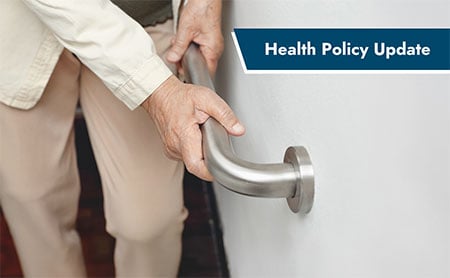Strengthening Policies to Prevent Older Adult Falls
July 15, 2025 | Amy Ciarlo, Clint Grant

Falls are the leading cause of death from unintentional injury among adults aged 65 years or older in the United States, with more than one in four older adults experiencing a fall each year. These falls have increased by 41% over the past decade, and falling even once doubles the risk of future falls. Further, older adults living with dementia are at even greater fall risk, with Alzheimer’s disease being the most common form of dementia. Older veterans are also at increased risk for falls due to poorer health outcomes than the general population and higher prevalence of developing aging-related disabilities.
In 2020, non-fatal falls cost an estimated $80 billion in emergency room visits, hospitalizations, and follow-up care. Despite the seriousness of older adult falls, less than half are reported to health care providers, making it more difficult to prevent future falls.
As the U.S. older adult population continues to grow, health care systems, caregivers, public health agencies, policymakers, and other partners must work together to address the risk factors that lead to preventable falls. Jurisdictions may coordinate with organizations and coalitions, in conjunction with other priorities that impact this population, such as affordable housing, transportation, healthcare, nutrition, and caregiving, which can reduce older adult falls risk.
Falls prevention is not explicitly addressed in most proposed or enacted legislation. However, policies that benefit older adults by improving standards in memory care facilities, increasing caregiver training and resources, and improving nutrition access can lead to better health outcomes and therefore reduce fall risk in older adults.
Proposed and Enacted Legislation to Prevent Older Adult Falls
At the federal level, Congress introduced the “Safe Steps for Veterans Act,” (HR 3183) focusing on prevention and management of falls among veterans by establishing an Office of Falls Prevention within the Department of Veterans Affairs (VA). Proposed responsibilities include developing standards of care, monitoring deficiencies, promoting research, and coordinating educational campaigns and resources related to falls prevention. The bill also outlines a pilot program to assess the feasibility of providing home modifications to prevent falls and mandates annual falls risk assessments and prevention services within veterans' extended care settings.
Also focused on veterans, Washington enacted SB 5200, which aims to better integrate and support medical foster home (MFH) options tailored for older adult veterans. This bill allows exemption from adult family home licensure requirements when care is provided to three or fewer veterans but would require oversight by the VA, following their MFH program. Caregivers can help veterans carry out daily living activities such as bathing and dressing, and provide assistance with medication, nursing, meals, and recreational and social activities. Washington also enacted SB 5337, requiring assisted living facilities that offer memory care services to meet a set of standards for programming, staffing, and physical infrastructure, including safe walking surfaces and physical assistance as needed.
Tennessee has enacted the "Caring for Caregivers Act" (HB 717), a three-year pilot program that offers grants to certain individuals caring for family members diagnosed with Alzheimer's disease or related dementias to offset caregiver expenses. Eligible expenses include home modifications that would allow an eligible family member to remain mobile, safe, and independent, and any purchasing or leasing equipment to assist an eligible family member in safely carrying out activities of daily living.
Falls Prevention Policy Strategies
Many health departments have relied heavily on federal funding to establish and expand falls prevention programs, but future funding remains uncertain. In this shifting environment, jurisdictions should continue to work with multisector partners to establish policies, systems, and environmental changes to reduce older adult falls. Some strategies to explore include:
- Update/improve building codes to reduce falls risk In partnership with a health system, establish a post-fall follow-up or referral system in hospitals.
- Design age-friendly communities and urban centers, including accessible transportation for those with limited mobility.
- Expand falls prevention screening into all health care settings that serve the older adult population (e.g., vision, hearing, podiatry).
- Require pharmacies to clearly label medications whose side effects can increase fall risk, such as dizziness and drowsiness.
- Provide tax incentives for home modifications.
Because falls prevention is a shared priority within community and clinical settings, strong collaboration is essential. Using CDC’s Stopping Elderly Accidents, Deaths, & Injuries (STEADI) initiative, ASTHO has piloted state-based programs that incorporate community-clinical linkages in their delivery. This included supporting the Iowa Department of Health and Human Services’ collaboration with the Iowa Community HUB to advance their state falls prevention efforts through provider recruitment, STEADI clinical integration, and program evaluation. Similarly, ASTHO aided the Oklahoma State Department of Health collaboration with their state Medicaid agency to expand STEADI clinical integration in their suite of evidence-based falls prevention programs.
Conclusion
By coordinating efforts among various partners across the nation, state, and local jurisdictions, older adult falls can be addressed through a multi-prong approach of effective policy, programming, and awareness.
ASTHO will continue to monitor policy and legislative developments that focus on older adult falls prevention and risk reduction.